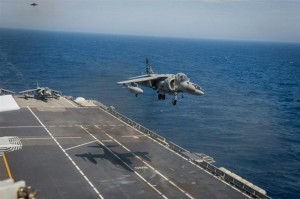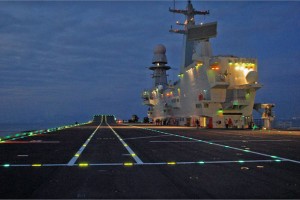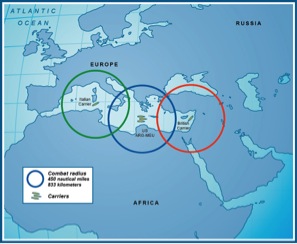2013-10-25 The Italian aircraft carrier ITS Cavour is the newest Italian carrier.
It has been born in the age of significant evolution of carrier aviation, weaponization and the evolution of ISR systems.
Its role is being shaped in part, by the dynamics of change in all of these core areas.
The ship was commissioned in 2008 and the ship is an extremely flexible asset able to play the role of a flagship for a maritime force or key element for a distributed coalition seabase in support of coalition operations.
According to an article published in Naval Technology:
The ship has a standard displacement at full load of 27,100t, an overall length of 244m and a sustained speed of 27kt. The carrier’s runway is 180m×14m with a 12° ski jump. It can accommodate up to 1,202 people on board, including the ship’s crew of 486, 211 aircrew, an amphibious command force of 140, and San Marco Battalion of 360, plus an extra 90 troops if required.
A strong feature of the ship is its high flexibility in operational terms. It is able to carry out the functions of an aircraft carrier as well as the transport of wheeled and tracked vehicles, for both military and civil missions. The aircraft hangar can accommodate 100 light vehicles or 24 main battle tanks for amphibious missions. The ship can also support four LCVP landing craft. There are two 30t elevators for aircraft and two 15t elevators for armaments.
The vessel is equipped with a flight deck suitable both for operations with helicopters and with short launch, vertical take-off fighter planes. It has a hangar / garage of approximately 2,500m² which can also accommodate wheeled and tracked land vehicles.
The ship can support eight VTOL (vertical take-off and landing) aircraft such as AV-8B Harrier or F-35 joint strike fighter VTOL variant, or 12 helicopters, such as the EH101, NH 90 or SH-3D, or a mix of platforms.
Under the influence of the Osprey and the F-35 fleet dynamic, along with the addition of new ISR and strike missile systems, the USN-USMC team is evolving the concept and operation of the sea base.

And the shift in the role of the support fleet operated by Military Sealift Command is redefining the role of support ships, so that the pressure on the reduced number of amphibious ships can be reduced by the broader inclusion of support ships within the overall functions of the sea base. The Osprey now able to operate off of the T-AKE ships is a case in point.
The two most recent Bold Alligator exercises, the one held in 2012 and the one in 2013, both have underscored the evolution of reshaping maneuver from the sea with new ships, aviation and C5ISR assets.
https://sldinfo.com/bold-alligator-2013-shaping-a-21st-century-insertion-force/
By having very flexible air assets operate across the Gator Navy, and the Osprey is the current driving force for change, the entire sea base operates differently.
Add the F-35 B as a “flying combat system” and the capabilities are not only enhanced by the role of each individual key ship, which can operate F-35Bs, will become key elements for the distributed force.
For the first time, amphibious ships and carriers the size of the Cavour will carry their own airborne C5ISR capabilities.
This means that the smaller ships will not only carry more organic punch, but be able to provide overwatch and strike support to a distributed fleet.
The intersection of land based and seabased assets can conjoined in coordinated operations as the F-35 fleet becomes a reality operating in the Mediterranean as well.
In an earlier piece, we looked at the “fit” between the evolutions of the new sea base approaches and changes in the global situation.
The Libyan operations as well as evolving events in the Middle East suggest even more strategic relevance of the rapid evolution of the sea-basing approach into a broader understanding of maneuver warfare from the sea.
The concept of maneuver warfare from the sea featured in BA-12 is not about amphibious ships, it is about leveraging them as part of sea base to shape a broad maneuver space to shape engagement options and mission success.
The “new” Middle East is rapidly creating the need for such a capability, and such a transformation of US and allied forces. And remember the core role, which allies played in BA-2012.
With the Arab Spring, the security and defense framework, which the West has underwritten over the past thirty years, is shattered. The Arab Spring states are in upheaval, the Iranians are preparing to enter the stage as a nuclear power, the Conservative Arab states have to prepare to defend themselves against Iran, and the interaction between Arab Spring forces and the stability of the key conservative Arab states is significant. Who will the West be aiding and abetting if the Arab Spring continues to pull the rug out from under the de facto Conservative Arab, Israeli and Western alliance?
Will Western states be able and willing to deploy land based forces, whether ground or air, on Arab soil? And given uncertainties even in key Arab allied states, how might the West best defend its interests, and to ensure energy security in the region?
A ship like the Cavour, operating F-35Bs, can form a centerpiece of a maritime operational force or provide overwatch and strike support for an allied coalition force, seen as a distributed force.
Given Italy’s key location in the Mediterranean, its land and sea based assets can be blended into a more coherent capability to protect Italian interests by more effectively combining its air assets around the F-35.
For example, if one looks at the Mediterranean and considers simply the deployment of three F-35B carriers, the Cavour, the new Queen Elizabeth class or the USS America class, the Mediterranean can be considered under the reach of the air fleet but one clearly considered not as an end in itself but as integral part of joint and coalition operations.

With the F-35, the key consideration is not simply range, but the reach of the fleet.
The graphic below looks at the impact of the seabased fleet in providing significant reach for Mediterranean operations for the allies:

The impact of the new combat systems aboard the F-35 an enabler which enhances the role of a ship like the Cavour.
We know from the performance of the F-35 radar in the Northern Edge Electronic Warfare exercise in 2011, that the radar can scan significant surface areas over water as well as land.
According to the F-35 Joint Program Office release at the time:
A return participant, the AN/APG-81 AESA demonstrated robust electronic protection, electronic attack, passive maritime and experimental modes, and data-linked air and surface tracks to improve legacy fighter situational awareness. It also searched the entire 50,000 square- mile Gulf of Alaska operating area for surface vessels, and accurately detected and tracked them in minimal time.
And of course, the radars of the F-35 fleet are designed to share their data with each other creating a grid over an operational area.
When the F-35B was on “probation,” many lost sight of the synergy between the aviation revolution and the changing dynamics of the sea base.
We did not.
Ed Timperlake underscored in the Fall of 2011 that the two went hand in hand.
The Italian commitment of a billion dollars to build a beautifully designed Aircraft Carrier for the F-35B is a tribute to the faith and commitment the Italian Government made for the US to keep it’s word….
The F-35 is part of enabling a coalition of like-minded states and shaping a global fleet capability. Allies worldwide are building ships upon which the F-35B could land and operate. Yet the myopic IOC cost focus, forgets the capability issue and notably coalition capability. In a cost downturn, the U.S. would wish to have less or more allies? The U.S. would wish to have a globally enabled fleet of C4ISR D aircraft or stovepiped fleets located on specific U.S. decks?
The US is clearly on probation here with regard to a core coalition partner who generously allows the US to operate off of Italian soil. As the USN considers its options, it would be useful to remember that throwing the Italian carrier into the dust heap of history by not building the F-35B makes NO strategic sense.
https://sldinfo.com/the-italian-carrier-the-f-35b-and-the-future/
Fortunately, Secretary Panetta saw it through, and the F-35B prepares for its IOC in 2015 and will move from Yuma, Arizona to Japan to spearhead the coming of the F-35 fleet to the Pacific.
This means that the Italian carrier is a key element of the expanding role of the sea base under the influence of the aviation revolution.
Editor’s Note: For a series of videos highlighting the Cavour as the flagship of a recent NATO exercise in the Mediterranean, Brilliant Mariner 13, see the following:
https://sldinfo.com/nato-tests-navies-crisis-response/
https://sldinfo.com/italian-carrier-cavour-in-exercise-brilliant-mariner-13-1/
https://sldinfo.com/italian-aircraft-carrier-its-cavour-2/
https://sldinfo.com/italian-aircraft-carrier-cavour-3/
https://sldinfo.com/italian-aircraft-carrier-cavour-4/
https://sldinfo.com/italian-aircraft-carrier-cavour-5/
With regard to the exercise see the following:
http://www.mc.nato.int/PressReleases/Pages/BRILLIANT-MARINER-13-steps-up-a-gear.aspx
http://www.eucom.mil/blog-post/25438/protectors-on-deck

